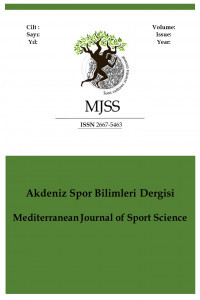Kick Boks Sporcularının Sporcu Kimlikleri ile Sportmenlik Yönelimlerinin İncelenmesi
Kick Boks, Kimlik, Sportmenlik Yönelimi
Investigation of Athlete Identity and Sportsmaning Orientation of Kick Boxing Athletes
Kickboxing, identity, sportsmanship orientation,
___
- Birkök, M. C. (1994). Bilgi sosyolojisi ışığında kimlik sorunu. Doktora tezi, İstanbul Üniversitesi, Sosyal Bilimler Enstitüsü, İstanbul.
- Brewer, B. W., VanRaalte, J. L., ve Linder D. E. (1993). Athletic ıdentity: hercules’ muscles or achilles heel?. International Journal of Sport Psychology, (24), 237-254.
- Çetinkaya, T. (2015). Takım sporlarında sporcu kimliği ve sürekli sportif kendine güven ilişkisi. Yayımlanmamış doktora tezi, Gazi Üniversitesi, Ankara.
- Ebrahim, R. M., Ghasem, M., ve Majid, JF. (2015). Factor Analysis Demographic Related of Sportmanship in Professional and Champion Athletes. Organizational Behavior Management In Sport Studies,2(5),65-72.
- Erdoǧan, B. S., & Gülşen, D. B. A. (2021). Investigation of the Faculty of Sport Sciences Students' Identity Perceptions According to the Variables of Gender and Doing Sports. International Journal of Applied Exercise Physiology, 10(1), 164-168.
- Erin J. Reifsteck. (2011).The relatıonshıp between athletıc ıdentıty and physıcal actıvıty levels after retırement from collegıate sports. Master’s Thesis. Graduate School at The University of North Carolina, Greensboro.
- Güllü S., ve Şahin S. (2018). Milli Güreşçilerin Sportmenlik Yönelim Düzeyleri Üzerine Bir Araştırma. Journal of Turkish Studies, 13(18), 705–718.
- Gümüş, H. (2019). X Kuşağında Sportmenlik Yönelimi. OPUS Uluslararası Toplum Araştırmaları Dergisi, 10(17), 738-755. Işık, U. (2018). Amatör ve Profesyonel Sporcu Lisanlarına Sahip Futbolcuların Sportif Kendine Güven Düzeyleri ile Sporcu Kimlikleri Arasındaki İlişki. Spor Eğitim Dergisi, 2(3), 26–35.
- Sezen Balçıkanlı, G., Gülşen, K. & Yıldıran, İ. (2017). Kadın Futbolcularda Sportmenlik Yönelimi. Gazi Beden Eğitimi ve Spor Bilimleri Dergisi, 22(14), 1-9.
- Sezen-Balçıkanlı, G. (2010). The Turkish Adaptation of Multidimensional Sportspersonship Orientation Scale-MSOS: A Reliability and Validity Study. Gazi Journal of Physical Education and Sports Science, 15(1), 1-10.
- Stornes, T., ve Bru, E. (2002). Sportspersonship and Perceptions of Leadership: An Investigation of Adolescent Handball Players Perception of sportspersonship and Associations with Perceived Leadership. European Journal of Sport Science, 2(6), 1-15.
- Ulukan, M. (2021). Farklı Dövüş Sporu Yapan Öğrencilerin Sportmenlik Yönelim Düzeylerinin Bazı Değişkenler Açısından İncelenmesi. Spor Eğitim Dergisi 5(1), 52-62.
- Öztürk, P., ve Koca, C. (2013). Sporcu Kimliği Ölçeğinin Türkçe Formunun Psikometrik Özelliklerinin İncelenmesi. Spor Bilimleri Dergisi, 24(1), 1-10.
- Vallerand, R. J., ve Losier, G. F. (1997). Self-Determined Motivation and Sportsmanship Orientations: An Assessment of their Temporal Relationshi. Journal of Sport and Exercise Psychology, 16(1), 229-245.
- Lamont-Mills, A., ve Christensen, S.A. (2006). Athletic Identity And its Relationship to Sport Participation Levels. J Sci Med Sport, 9(1), 472-478.
- Matheson, H., Brewer, B., & Van Raalte, J. (1995). Athletic identity of national level badminton players: a cross-cultural analysis. Science and racket sports, 228.
- Proios, M., Proios, M.C., Fotis., Mavrovouniotis, F., ve Theofanis, S.(2012). An Exploratory Study of Athletic Identity in University Physical Education Students. Graduate Journal of Sport, Exercise & Physical Education Research, 1(1), 98-107.
- Saraç, L., ve Toprak N., (2017). Sporcu Kimliği ve Homofobi İlişkisinin Sporcu İncelenmesi. Spormetre, 15(2), 79–84.
- Wiechman, S.A., ve Williams, J. (1997). Relation of Athletic Identity to Injury and Mood Disturbance. Journal of Sport Behavior, 20(1), 199-210. Yalçın, Y. G., Tek, T. ve Çetin, M. Ç. (2020). Amatör Olarak Spor Yapan Üniversite Öğrencilerinin Sportmenlik Yönelimlerinin İncelenmesi. Türk Spor Bilimleri Dergisi, 3(1), 29-34.
- Yayın Aralığı: Yılda 4 Sayı
- Başlangıç: 2018
- Yayıncı: Hasan ŞAHAN
Çocuk Sporcuların Rekreasyonel Egzersize Katılım Motivasyonu ve Mutluluk Düzeylerinin İncelenmesi
Melike ESENTAŞ DEVECİ, Özge YAVAŞ TEZ, Pınar GÜZEL GÜRBÜZ
3X3 Basketbol İle 5'e 5 Basketbolun Oyun İçi İstatistiklerinin Analizi
Doping Amacıyla Sık Kullanılan İlaçların Biyokimyasal Etkileri
Şaban ÜNVER, Seydi Ahmet AĞAOĞLU, Büşra TÖREN
Futbolcu Çocuklarda Terabant Egzersizlerine Performans Yanıtları
Serdar BAYRAKDAROĞLU, Mehmet Onur SEVER, Ebru ŞENEL, Gökmen KILINÇARSLAN, Akan BAYRAKDAR
Ragbi Sporcularında Duygusal Zekâ ve Kişilik Özellikleri Arasındaki İlişkinin İncelenmesi
Aydıner Birsin YILDIZ, Duygu BÜLBÜL, Gözde ALGÜN DOĞU
Erkan ÇİMEN, Abdullah Yavuz AKINCI
Kick Boks Sporcularının Sporcu Kimlikleri ile Sportmenlik Yönelimlerinin İncelenmesi
Vücut Ağırlığıyla Yapılan Kuvvet Antrenmanının Dinamik Dengeye Etkisi
